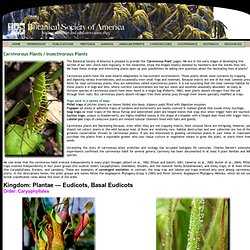

Carnivorous and Insectivorous Plants Online, Dionaea (Venus Flytrap), Nepenthes (Monkey Cup), Drosera (Sundew), Aldrovanda (Waterwheel), Cephalotus, Pinguicula, Sarracenia, Brocchinia, Byblis, Catopsis, Darlingtonia, and many others - Botanical Society of. The Botanical Society of America is pleased to provide the "Carnivorous Plant" pages.

We are in the early stages of developing this section of our site; check back regularly. In the meantime, enjoy the images (mainly donated by members) and the stories they tell. We hope these strange and interesting plants open up your possibilities for asking new questions about the fascinating lives of plants! Carnivorous plants have the most bizarre adaptations to low-nutrient environments. These plants obtain some nutrients by trapping and digesting various invertebrates, and occasionally even small frogs and mammals. BSA Image Collection. Bonsai styles, shapes and forms explained. Over the years many styles to classify Bonsai trees have been advanced, closely resembling circumstances in nature.

These styles are open to personal interpretation and creativity, meaning that trees do not necessarily need to conform to any form. Still, the styles are important to gain a basic understanding of shapes and should serve as guidelines to successfully train miniature trees. Bonsai styles movie. Mushroom Pictures & Mushroom Reference. Ames® - Home. American Journal of Botany. Synsepalum dulcificum. The berry itself has a low sugar content[7] and a mildly sweet tang.
It contains a glycoprotein molecule, with some trailing carbohydrate chains, called miraculin.[8][9] When the fleshy part of the fruit is eaten, this molecule binds to the tongue's taste buds, causing sour foods to taste sweet. At neutral pH, miraculin binds and blocks the receptors, but at low pH (resulting from ingestion of sour foods) miraculin binds protons and becomes able to activate the sweet receptors, resulting in the perception of sweet taste.[10] This effect lasts until the protein is washed away by saliva (up to about 60 minutes).[11] The names miracle fruit and miracle berry are shared by Gymnema sylvestre and Thaumatococcus daniellii,[2] which are two other species of plant used to alter the perceived sweetness of foods.